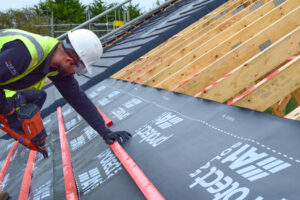3 mins

With larger fines and stricter sentencing guidelines Ian Hollingworth, Head of Claims for ECIC, effective and robust approach to complying with health and safety laws.

The number of fines that are reaching six and seven figures for Health and Safety at Work offences have risen starkly in England and Wales over the last few years. The reason for the sharp rise in fines is due to changes introduced by the UK Sentencing Council in 2016. Furthermore, in November 2018, new Sentencing Guidelines were introduced specifically in relation to gross negligence manslaughter.
Roofers therefore need to operate ever more thoroughly or risk facing potentially sky-high fines for Health and Safety breaches—or even a jail term.
The reason for the change in the severity of fines is down to concerns that the previous sanctions for health and safety offences were too low and were not doing enough to deter unsafe practices. Therefore in 2016, the Sentencing Council confirmed major modifications to the penalties for health and safety at work offences.
Under new guidelines, new fines are set relative to the size of the business and the potential harm that could have been caused. In essence, the fines are now intended to have an ‘economic impact’ on the employer concerned.
Prior to the new guidelines, fines typically ranged between £250,000 and £500,000 for the most serious offences. Today, dependant on the company’s annual turnover (as opposed to profitability), the fine could be as much as £10million for exactly the same incident.
These changes have already had a significant impact. The average fine per case in 2016/17 was approximately £126,000. This is more than double the average fine in 2015/16. According to the Health and Safety Sentencing Guidelines One Year On report published by IOSH in partnership with Osborne Clark LLP, Jan 2017, the 10 highest fines in 2017 ranged between £1.35m and £3m, contrasted to the largest fine paid in 2014 which was £600,000.
As a specialist insurer for the contracting sector, our main concern at ECIC is the potentially disproportional impact on mid-size roofing contractors with turnovers between £10m and £50m. Due to the wide bracket of fines under the new guidelines, (ranging from £1000 to £4m), roofing businesses could face a fine similar to that of a much larger contractor.
A large roofing contractor with a turnover exceeding £50m convicted of corporate manslaughter, may now face fines of up to £20m. In addition, individuals such as company managers or directors who are found guilty of a breach of their duty of care to their employees could face jail. Under the revised Guidelines for gross negligence manslaughter introduced in November 2018, there is now the potential for a massive increase in custodial sentences.
Clearly the way to avoid facing such heavy penalties is to have an effective and robust approach to complying with health and safety laws.
The risks at every site must be carefully considered and site-specific risk assessments and method statements drawn up before works commence rather than relying on generic assessments.
Every worker should sign site specific health and safety assessment forms at the outset of each job to ensure they are aware of any risks, the control measures in place and the personal protective equipment needed.
A signed, dated document is a key piece of evidence that contractors need as part of how they can demonstrate that risks have been identified and reduced to the lowest possible level in compliance with the relevant statutory duties of care and Health and Safety Regulations.
Without this, a roofing contractor could find themselves exposed to claims for civil damages and if serious enough a prosecution by the HSE which may ultimately lead to a significant fine or even imprisonment. The risk both to staff and to the reputation of the business is simply not worth taking.



